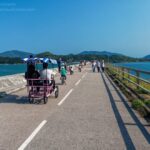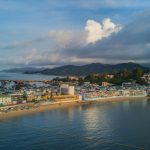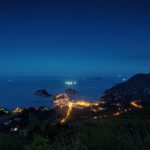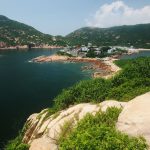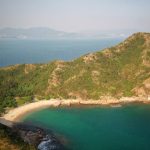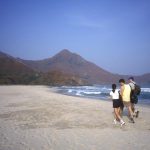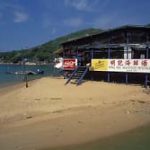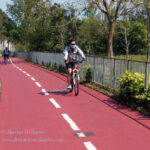Hong Kong’s climate is sub-tropical, with a hot, steamy summer eventually yielding to a drier, warm to hot autumn, then sometimes cool winter, and the swiftly warming, sometimes rainy spring. There are two major monsoons, with fairly consistent winds: the southwest monsoon of summer, which can bring great deluges, and the northeast monsoon of winter, which can be surprisingly chill. And, especially in late summer, Hong Kong is sometimes impacted by tropical storms, which when most intense are among the world’s most powerful weather phenomena: typhoons.
Though the summer temperatures may not seem extremely high – the record for Hong Kong is 36.1C, and more typical daytime highs are around 31-34C – it feels considerably hotter because the humidity is high, often 80 percent or more. (A table on this Heat index and wind chill index page indicates that with a temperature of 33C and 80 percent humidity, it feels like 47.3C; it’s effectively so much hotter because sweat barely evaporates, so you hardly cool down.)
And, in many places, it actually is hotter – the temperature records at the Hong Kong Observatory in Tsim Sha Tsui are often one to two degrees lower than those recorded at other weather stations (in winter, these stations may record lower temperatures than the observatory).
Even at night, the temperature doesn’t drop much below 30C, so hiking at dawn and dusk isn’t real comfortable either. Perhaps surprisingly, Hong Kong in summer can be a darm sight more uncomfortable than even some places nearer the Equator – in large part I think because of the sustained high humidity.
This heat means that summer isn’t a time for long hikes; indeed, even short hikes can seem relatively hard going on the hotter days. And if you aim to be active outdoors, take care! Occasionally, hikers have died of heatstroke; others have suffered dehydration.
When Hong Kong’s heat is on – drink!
If you’re active in summer, drink lots of fluids – not just water, you have to maintain your salt balance (I favour drinking both water and sports drinks, as well as eating salty food). As well as drinking before you set off, you should carry plenty – perhaps allowing for a litre an hour – or at least be certain you’ll never be far from somewhere you can buy drinks. Especially if you’re not accustomed to being out and about in Hong Kong’s hot summer weather, don’t plan on doing too much; take it easy.
(8 August: just back from a hike to Ng Tung Chai waterfalls, an hour’s hike up, then at waterfalls, 40 mins down, maybe 3 hours in all; drank 500ml Lucozade sports drink as setting off, and around 700ml water and 500ml Pocari Sweat [!!] during outing, sweating enough to leave my shirt wringing wet. Felt fine. Maybe this gives better indication of conditions, amounts of liquid to take.)
The sun can be intense, too; for protection use strong sunblock, also sun hat, maybe long-sleeved clothing (which, if you can bear it, will also help against mosquitoes in Hong Kong).
Though I still don’t relish pouring with sweat when walking in summer, there is an upside: with winds often from over the South China Sea, the scenery is at its scintillating best during this season. There’s real magic in being out when there’s an intense blue sky dotted with bright white clouds, above a lush green landscape. And there’s chance to cool off, maybe in pools below cascades, or at beaches.
There’s also some respite from the heat if you go higher, such as high on Tai Mo Shan, or to Ngong Ping on Lantau, which can be great when there’s a breeze from over the sea.
Monsoon downpours
And rainstorms also bring relief from the Hong Kong heat. The worst rains are usually associated with southwest monsoons, centred around June; occasionally, deluges seem never ending, with clouds overhead so thick you need lights on, the rain noisily drumming off the ground, and perhaps some dramatic thunderstorms. Parts of Hong Kong may flood; and because even small streams can become torrents, caution is needed if you are caught in a storm, or hike soon after one. (If soon afterwards, consider heading to a waterfall, which could be especially impressive.)
There are also heavy rains associated with tropical storms, and typhoons.
Ah, cooler autumn – and the dreaded smog
Autumn is slow to bring real change in the weather; the heat lingers, but at least nights become a tad cooler. Eventually, the high pressure cells begin to build over north Asia, the strongest of them surging southwards to bring blustery north winds and lower temperatures to Hong Kong. With warm, humid air typically loitering ahead of these cold surges, the temperature changes can be rapid, and substantial – perhaps well over 10C within 24 hours. (One such surge my first year in Hong Kong, I was wearing a t-shirt one day, the next I was scurrying to an electrical shop to buy a heater, another store for a duvet.)
Between the surges, the weather is warm, but not hot: ideal for getting out and about.
Further such surges punctuate the winter; sometimes the winds are dry, the sky clear, but especially later in the winter the air can be moist, the sky overcast, and there’s chance of drizzle. Temperatures may barely rise above 12C – which is warm relative to temperate winters, but in Hong Kong the buildings aren’t designed for this, and the temperature indoors can be roughly the same as out: downright chilly! (The wind chill can bring temperatures below zero Celsius; occasionally, the temperature in the hills drops below zero – when especially cold surges are forecast, some Hongkongers make pre-dawn trips to upper Tai Mo Shan in hopes of seeing frost. Once, even from sea level, I saw the upper slopes of Lantau and Sunset Peaks were white with frost.)
Spring starts around the middle of March, with risihg temperatures and humidity sometimes producing fog. Rains tend to become heavier, and the summer is soon upon us, with late April typically way hotter than the start of the month. I’ve heard that locals may not pack away their winter clothes till the Dragon Boat Festival, in the beginning of June – but cool spells are rare from late April, and for most days you can confidently predict: it’ll be hot … or very hot.
There are a couple of websites dedicated to Hong Kong’s weather (and climate). Weather Underground of Hong Kong was the first to be established, and is essentially a weather enthusiasts’ site, carrying some recent info from the Hong Kong Observatory as well as recordings from other (non observatory) weather stations in Hong Kong, and with English and Chinese weather forums, and a host of useful links.
Hong Kong Observatory is the site for the government organisation in charge of monitoring and forecasting Hong Kong’s weather (also tides, seismic activity etc). This has much improved over the years, and now has tons of useful pages and info – coupled with forecasts, the weather radar images can be a boon in guaging whether you’re about to be hit by a rainstorm.

